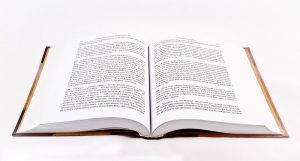Proper book manuscript format assures that a book looks professional and is easy to read. Each book printing company will have certain rules about the format they want your manuscript submitted in. The manuscript may need to be submitted as an RTF, DOC file, or printable PDF. The book printing company will have specifications about page size and margins. Digital printing services will have different requirements than softcover book printing services. Such specifics can be provided by your selected book printing company.
The interior book design suggestions below are universal and should be followed regardless of what book printing company you use.
Title Page
Every book should have a distinct title page which should include the title, author name, and publisher, where applicable.
The title page should always appear on the right side of the finished book. This is the side where the odd-numbered pages should be.

Typically, the copyright page should appear after the title page and include the written ISBN number, the name of the intellectual property holder, and the year. Often, there is also a note about the limitations of use such as a notice that no one may copy any part of it without permission. Additionally, any other notices such as the work being fictional and any similarities to real entities being unintentional and coincidental can also be on this page.
Chapter Breaks
Most books are broken into chapters. Every chapter should start on its own page. The chapter header and any chapter numbers should be capitalized along with the chapter title. These should appear approximately 1/3 of the way down the page. Like the title page, new chapters should appear on the right-side page of an opened book. The title headers should also be in a larger font and/or set in bold to be easily recognizable to readers.
Scene Breaks
In works of fiction, scene breaks should be clearly indicated. These can be one to three centered symbols on a page. Most commonly these are asterisks or hashtags but some people use decorative symbols that are book-specific such as a sword in a fantasy novel. In a printed book, a scene division can also be three entries of the return key to create a three-line gap.
If the goal is eBook publishing, you should use a visible symbol because line breaks can be harder for readers to see on an e-reader than they are in a print book.
Miscellaneous
Paragraphs should be indented in a fiction book. In non-fiction, paragraphs may be indented or line breaks can be used to divide paragraphs. All books should be printed using a standard, easy-to-read font.
Typically, books should be printed in 12-point font. Large print books should have between 16- and 18-point font sizes, and may need to follow different guidelines for spacing, contrast, and images within the book depending on the target community.
InstantPublisher Can Help
InstantPublisher is a book printing company that is easy to work with and eager to help with all your book printing needs.
We offer a wide range of services for self-publishing authors including layout and typesetting services. Our expert staff is available to assist you at 1-800-259-2592. Call today, fill out our online contact form, or send an email to questions@instantpublisher.com.

